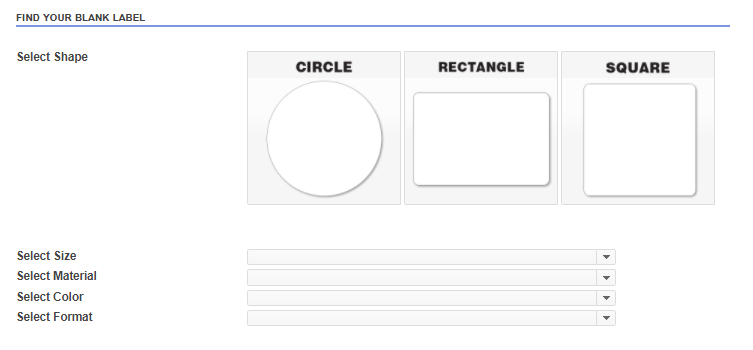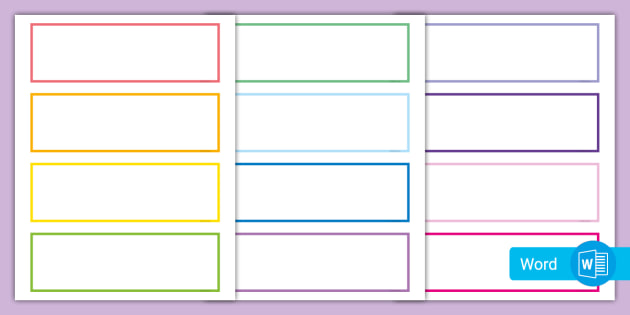Comprehending Exactly How Blank Labels Work to Boost Your Labeling Experience
Understanding the auto mechanics of blank labels is crucial for optimizing your labeling practices across different contexts. To completely comprehend how these labels can change your processes, one should take into consideration the various kinds readily available and the myriad means they can be personalized to match details needs.

Advantages of Making Use Of Blank Labels
Blank labels provide a versatile option for different classifying requirements, making them vital in both personal and specialist settings. Their flexibility allows individuals to create personalized labels tailored to certain requirements, boosting organizational effectiveness. Whether made use of in office, retail settings, or industrial applications, blank labels assist in the recognition and categorization of items, files, and individual items.
One considerable advantage of blank labels is their cost-effectiveness. By permitting users to print only the labels they need, waste is reduced, and supply monitoring becomes much more workable. Furthermore, blank labels are suitable with numerous printing methods, including inkjet and laser printers, making them easily accessible for various customers.

In addition, making use of blank labels streamlines the process of upgrading information, as customers can easily publish brand-new labels to replace out-of-date ones, ensuring that all products and records are accurately identified. Overall, blank labels give a functional and reliable labeling solution for diverse applications.
Kinds of Blank Labels Available
What options are offered when it involves blank labels? Blank labels come in a range of kinds, each matched for different applications and preferences. The most typical kinds include paper labels, which are versatile and economical, making them ideal for everyday use. They are offered in numerous finishes, such as matte and shiny, allowing for aesthetic versatility.
Another popular alternative is artificial labels, usually made from materials like polyester or vinyl. These labels are known for their toughness and resistance to water, chemicals, and tearing, making them ideal for rough environments. They are commonly used in industrial settings or for labeling products that may be exposed to moisture.
Additionally, there are thermal transfer labels, which require a printer that uses heat to transfer ink onto the tag surface area. These labels are preferred for their high-grade print and durability.
Finally, specialty labels satisfy particular needs, such as removable labels for temporary usage or high-temperature labels for severe conditions. Understanding these options enables individuals to select one of the most ideal blank tag for their special labeling requirements.
Customization Options for Labels
A wide selection of modification choices is available for labels, permitting customers to tailor them to details needs and branding needs. Customers can choose from various dimensions, forms, and materials to ensure that the labels effectively fit their desired function. Typical materials consist of paper, polyester, and vinyl, each offering various levels of resilience and visual charm.
Shade choices play a vital role in modification, enabling brand names to maintain uniformity with their business identity. Customers can select from a range of colors or perhaps opt for personalized printing to match particular branding components. Furthermore, labels can be published with distinct designs, logo designs, and text, improving brand name recognition and aesthetic impact.
One more vital aspect is the selection of adhesive. Labels can be developed with long-term, detachable, or repositionable adhesives, depending upon the application needs. This flexibility enables reliable labeling solutions across numerous environments, from retail to industrial setups.

Tips for Effective Labeling
Reliable labeling goes past customization; it additionally includes strategic factors This Site to consider that enhance capability and communication. To accomplish effective labeling, start by clearly specifying the function of each tag.
Next, focus on visibility by picking suitable shades and fonts. High comparison between message and background boosts readability, while larger try this site typefaces help with fast identification. Furthermore, ensure that labels are placed in a constant and logical way, making it easier for individuals to situate and interpret info.
Think about the longevity of labels. Select products suited for the certain setting where the labels will be utilized, whether it be inside your home or outdoors. Water-proof or tear-resistant options may be essential depending on the context.
Finally, consistently review and update your labels to mirror any kind of changes in information or usage. This positive strategy not just maintains clarity however likewise prevents complication in time. By complying with these ideas, you can optimize the performance of your labeling efforts, ensuring they serve their designated function effectively.
Applications of Blank Labels
Blank labels supply countless applications throughout numerous sectors, making them an important device for company and communication. These flexible labels are frequently utilized in storehouses for stock administration, allowing companies to quickly identify and track products. By using blank labels to storage space containers, racks, or pallets, firms can enhance their operations and decrease the possibility of errors.
In the medical care field, blank labels play a critical duty in classifying medicines and medical materials, making sure appropriate identification and use. Adjustable labels can include essential details such as dose, expiration days, and individual details, boosting safety and conformity.
In retail, blank labels help in pricing items, offering promotions, or classifying shelf areas, which eventually enhances the consumer experience. They enable for quick updates to prices or product information without the demand for pre-printed labels.
Moreover, blank labels are advantageous for individual use, such as arranging home offices, crafting, or classifying food containers. Their versatility allows people to create customized solutions that meet certain needs. On the whole, the applications of blank labels are comprehensive, underscoring their value in fostering effectiveness and quality in different setups.
Conclusion
In final thought, blank labels provide a functional and reliable solution for various identifying requirements. Inevitably, the combination of blank labels right into operational processes contributes to enhanced effectiveness, try this making them an invaluable resource for both personal and professional use.
Comments on “Explore our wide selection of Blank Labels to match your requirements.”